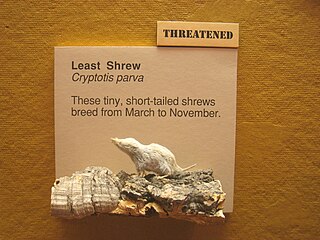
The genus Cryptotis is a group of relatively small shrews with short ears, which are usually not visible, and short tails, commonly called small-eared shrews. They have 30 teeth and are members of the red-toothed shrew subfamily. Since 1992, Neal Woodman at the United States National Museum has been in the process of revising the genus. To date, this has resulted in an increase in the number of species from 12 to 30.

Anomalochromis is a genus of fish in the family Cichlidae, containing the single species Anomalochromis thomasi, the African butterfly cichlid. It is a small cichlid growing to a length of 6–8 centimetres (2.4–3.1 in). The natural habitat of A. thomasi is Sierra Leone, Liberia and Guinea, mainly in smaller streams. The fish are typically found in slightly acidic, oxygen rich water with other west African cichlid genera such as Hemichromis and Pelvicachromis.

Thomas's nectar bat is a bat species from South and Central America.
The giant Atlantic tree-rat is a spiny rat species from Brazil.
Thomas's giant deer mouse is a species of rodent in the family Cricetidae. It is found only in Mexico.

Thomas's shrew tenrec is a species of mammal in the family Tenrecidae. It is endemic to Madagascar. Its natural habitat is subtropical or tropical moist lowland forests. It is threatened by habitat loss.
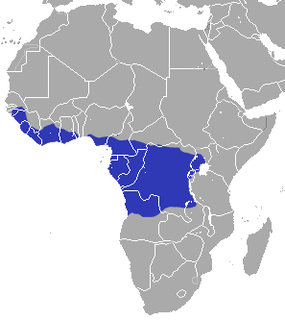
Thomas's bushbaby is a species of primate in the family Galagidae. It is found in Angola, Burundi, Cameroon, Democratic Republic of the Congo, Equatorial Guinea, Gabon, Kenya, Nigeria, Rwanda, Tanzania, Uganda, and Zambia.

Thomas's small-eared shrew is a species of mammal in the family Soricidae. It is found in Colombia, Ecuador, and Peru.
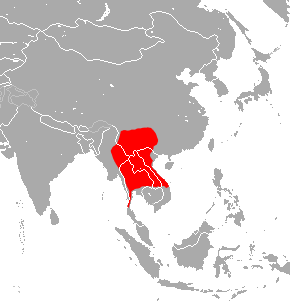
Thomas's horseshoe bat is a species of bat in the family Rhinolophidae. It is found in China, Laos, Myanmar, Thailand, and Vietnam.

Thomas's pika, also known as the Thomas-pika, is a species of small mammal in the pika family, Ochotonidae. The fur on its upper body is reddish brown in summer, and mouse grey in winter. It is a generalist herbivore threatened by habitat loss, being found on isolated peaks of the eastern Qilian Mountains in Qinghai, Gansu, and northwestern Sichuan, in China. The International Union for Conservation of Nature Red List of Endangered Species assessed the animal as insufficiently known in 1994, as near threatened in 1996, and as a species of least concern in 2008.
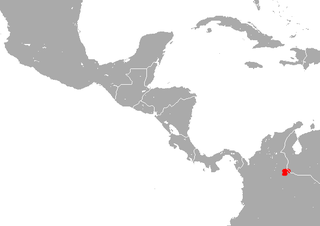
The Tamá small-eared shrew is a species of mammal in the family Soricidae. It is known from the Cordillera Oriental of Colombia and the Páramo de Tamá of western Venezuela, where it has been found primarily in cloud forest at elevations between 2380 and 3330 m. Its range includes Venezuela's El Tamá National Park. The closest relatives of the species are C. meridensis and C. thomasi.

Cyclops bicuspidatus is a planktonic species of copepod found throughout the world, except Australia, and characteristic of the Great Lakes of North America. It is a deep water species found throughout the year with peak abundance occurring in May or June. Males grow up to 0.8–1.0 millimetre (0.031–0.039 in) long, while females are larger at 0.9–1.6 mm (0.035–0.063 in).
Norfolkia thomasi, known commonly as the Thomas' triplefin, is a species of triplefin blenny in the genus Norfolkia. It was described by Gilbert Percy Whitley in 1964, naming it in honour of Leonard Rees Thomas who organised the Australian Museum's 1962 Swain Reefs Expedition. The hemispherical eggs of the Thomas' triplefin are covered in sticky threads that help anchor them in the algae on their nesting sites. This adaption helps insure the safety of the eggs. One the eggs hatch the larvae that emerge are planktonic and they stick to shallow waters near the shore. The matured Thomas' triplefin then ventures out into the coral reef and intertidal pools. This species is found in the western Pacific Ocean from the Ryukyu Islands to the Tuamoto Archipelago, in Australia it is distributed from the northern Great Barrier Reef south to Byron Bay, New South Wales.
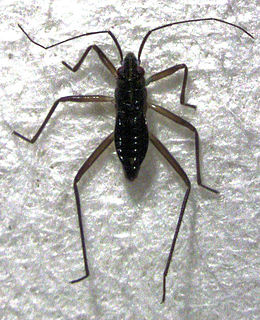
Mesovelia is a genus of water treaders in the family Mesoveliidae. There are more than 30 described species in Mesovelia.
Ceuthophilus hesperus, the San Diego camel cricket, is a species of camel cricket in the family Rhaphidophoridae. It is found in North America.

Diacyclops is a genus of cyclopoid copepods in the family Cyclopidae. There are more than 120 described species in Diacyclops.

Cyllodes is a genus of sap-feeding beetles in the family Nitidulidae. There are about 14 described species in Cyllodes.

Cyclargus thomasi, known generally as the Thomas's blue, Miami blue or Caribbean blue, is a species of butterfly in the family Lycaenidae. It is found in North America and the West Indies.

Acanthocephala thomasi, the giant agave bug, is a species of leaf-footed bug in the family Coreidae. It is found in Central America and North America.














